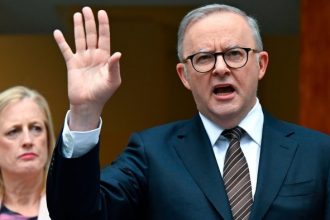Nato is set to announce that most of its members are on track to hit the alliance’s defence spending target as it prepares for more Russian aggression and braces for the potential election of Donald Trump.
According to three officials, Nato will say on Wednesday that 18 of its 31 members will meet the target of spending 2 per cent of gross domestic product on defence this year, with that number likely to rise as budgets are adjusted.
“Nato expects about two-thirds of allies to hit 2 per cent in 2024,” an alliance official told the Financial Times.
Nato’s spending rose markedly after Russia’s full-scale invasion of Ukraine but Trump’s term in office in 2017-21 also brought a significant uptick as the US president harangued his European allies for failing to spend enough.
In 2016, only five countries met the target. Today Poland spends 3.9 per cent of GDP on defence, ahead of the US itself on 3.5 per cent. Other countries such as Spain trail, spending just above 1 per cent.

A declared Nato-sceptic and isolationist, Trump — the presumptive Republican nominee in November’s US presidential election — has previously threatened to withdraw from the military alliance that guarantees Europe’s defence and security.
His rhetoric has continued into the current race for the White House. European leaders were shocked last week when Trump told a campaign rally that he would encourage Russia to do “whatever the hell they want” with Nato members who fail to meet the target.
As Trump performs strongly in opinion polls against incumbent Joe Biden, he is again causing trepidation at Nato’s headquarters in Brussels.
European diplomats and officials say that continuing their upwards spending trajectory is the first of a three-plank Trump containment strategy.
Second, Nato must pivot to focus more on issues that are most important to Trump, such as containing China or tackling terrorism. Finally, allies understand that they must indulge in flattery and charm to win his admiration.
“There’s a lot of talk about [Trump],” said one senior Nato diplomat. “What is the best way to handle a future President Trump? . . . Basically a combination of flattery and a firm hand.”
Despite the increased defence spending since Russia invaded Ukraine, the sole guarantor of Europe’s security remains the US commitment to Nato, with no substitute for its 80,000 troops on the continent, the scale and speed of how it can deploy materiel, and its nuclear weapons capability.
“You can’t worry about the rhetoric too much, but instead focus on the points being made and make sure you give credit to Trump if and when he is right,” said Oana Lungescu, Nato’s chief spokesperson from 2010 to 2023.
“His priorities were pretty clear from the start. It’s about identifying those priorities, putting them in the alliance context and making sure that addressing them will strengthen the alliance,” she added.
Trump’s remarks on Russia have “underscored an existing anxiety about the implications of another Trump presidency,” said Ian Lesser, vice-president of the German Marshall Fund. “It could be more difficult on many levels. For one, Europe is now at war. And another Trump administration is likely to be more pointed in many policy areas and more capable of carrying them out.”
Trump’s first Nato summit, in Brussels in 2017, is remembered for the new US president lashing out at his allies for “owing” money to the US, failing to make reference to its Article 5 mutual-defence clause, and making disparaging remarks about the cost of the alliance’s new headquarters.
The following year, leaders spent the summit telling Trump he was the reason they would be increasing their defence spending. The stakes were high: the summit took place just before he flew to Helsinki to meet Russia’s President Vladimir Putin.
“The people have stepped up today like they’ve never stepped up before . . . $33bn more they’re paying,” Trump told reporters after the 2018 summit. “Everybody in the room thanked me. There’s a great collegial spirit in that room that I don’t think they’ve had in many years.”

A year later, Trump’s rhetoric on Nato had softened. He even defended the alliance in 2019, saying it “serves a great purpose” after French President Emmanuel Macron declared it “brain-dead”.
Trump’s sometimes difficult relationship with Macron, and his negative attitude towards Germany, were features of his first presidency that diplomats say could be repeated.
But other Nato leaders may be able to leverage closer relations with his possible administration.
Asked about Trump’s comments this weekend, Hungarian premier Viktor Orbán, a fan of the former US president who has maintained close ties to Putin and has held up EU aid for Ukraine, indicated he was not concerned. “We understand what Mr President said, and we pay our dues,” a spokesperson for Orbán told the FT. Hungary is among the Nato countries spending more than 2 per cent on defence.
Stefano Stefanini, Italy’s former ambassador to Nato, said Trump’s re-election would be a defining moment for Europe’s postwar security order.
“The problem Trump raises . . . is the refusal of America, of Trump’s America, to commit itself to the defence of Europe in case of aggression,” he said. The risk for Nato would be of it fracturing if capitals were individually to seek to curry favour with Trump, he added.
The potential need to mollify Trump is being factored into discussions over who succeeds Jens Stoltenberg, Nato’s secretary-general, when he steps down later this year. Dutch Prime Minister Mark Rutte, who had a productive relationship with Trump during his time in office and has recently praised his stance towards Nato spending targets, is widely considered as likely to get the job.
Dubbed the “Trump whisperer” for keeping the alliance together during his presidency, Stoltenberg adopted a strategy of targeted media messaging to make the case for Nato’s value. He peppered his appearances on American television channels favoured by Trump with words such as “strong”, “fair”, “win” and “leadership”.
His team also commissioned a bar chart showing increased defence spending in green and budget cuts in red. Trump’s years in office were all green: he would regularly cite it in his speeches and press events.
“Fundamentally, it’s about signalling why he has an interest in doing something that we also want,” said a senior European official who was involved in negotiations with Trump during his first term. “On almost all things he’s more transactional than ideological.”
Read the full article here




